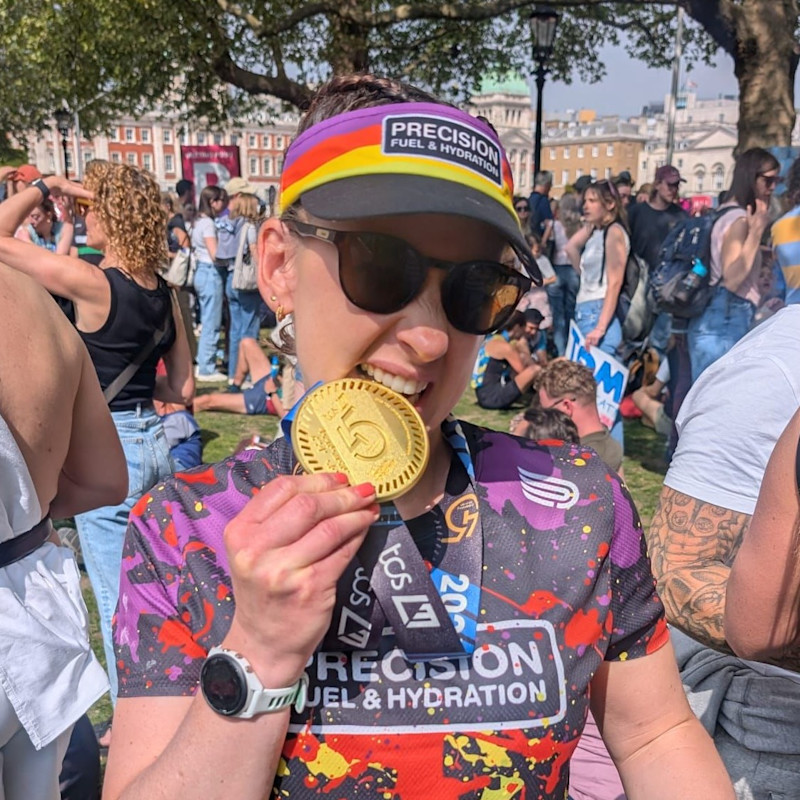
Rachel Ralph
London Marathon
Rachel's headline numbers
Rachel's strategy
Fueling
Carbohydrate is the main fuel you burn when racing. Failing to fuel properly is a leading cause of underperformance in longer races.
Rachel followed a structured, well-practised fueling strategy that helped her maintain her energy and pace, ultimately achieving a personal best marathon performance. She alternated between PF 30 Gels and PF 30 Chews, stored in her vest and shorts pockets, every 30 minutes to hit the recommended carb guidelines. She tolerated this excellently, with no GI issues even in the hotter-than-anticipated conditions, which was testament to the months she spent training her gut in her long runs, including a half marathon in the build to London.
Hydration
Taking on board an appropriate amount of fluid and sodium is essential to maintaining blood volume and supporting the cardiovascular effort needed to perform on race day.
Whilst the absolute amount of sodium and fluid consumed per hour is important, it’s critical to consider these in relation to each other. This is known as 'relative sodium concentration' and it’s expressed in milligrams per litre (mg/L). How much sodium you’re taking in per litre of fluid is more important than the absolute amount taken in per hour.
Sweat sodium concentration (mg/L) is largely genetically determined and remains relatively stable. Knowing how salty your sweat is enables you to replace a good proportion of your sweat losses, which can range from 200-2,000mg/L.
Whilst Rachel’s losses are on the moderate side, getting her hydration strategy right is still important if she wants to perform at her best.
Learn moreAfter preloading with PH 1500 beforehand, Rachel started the marathon with a hydration vest containing two 500ml soft flasks, one filled with PF Carb & Electrolyte Drink Mix and the other with PH 1000 (Drink Mix). When she finished her soft flasks around 2.5 hours into the race, she switched to picking up 250ml bottles of water from aid stations roughly every half an hour to continue replacing her sweat fluid losses. On top of this, Rach maintained her electrolyte balance by proactively replacing her losses at a concentration close to her sweat sodium concentration initially with her drink mixes and then by taking one Electrolyte Capsule with every bottle of water, as temperatures rose. Anticipating a warm day, Rachel had also built a cooling strategy into her plan, using water from aid stations and the on-course water hoses to help keep cool.
Caffeine
Beyond the Three Levers of Performance (carb, sodium and fluid), caffeine is one of only a few substances that is proven to improve performance for most endurance athletes as it can help stave off mental and physical fatigue.
Rachel chose not to take any additional caffeine during the race beyond her usual pre-race coffee, and it did not hold her back on the day from achieving her performance goal. Instead, it lowered the risk and fears of possible negative side effects from the stimulant. Whether or not an athlete chooses to use caffeine comes down to personal preference and tolerance, as it’s not one of the fundamental three levers of endurance performance. So, Rachel made the sensible choice here having not tested PF 30 Caffeine Gels in her training.
How Rachel hit her numbers
Here's everything that Rachel ate and drank on the day...
Rachel's weapons of choice
Final thoughts
Rachel's full stats
Data Confidence?
There is good confidence in the accuracy of the data reported. An athlete feels that the numbers closely reflect what they consumed despite a couple of estimations which may carry some degree of error. The majority of what was consumed is recorded to a high level of specificity (most volumes are known through the use of bottles brands quantities flavours). The numbers are very plausible and align with previous data recordings (if an athlete has collected data previously).